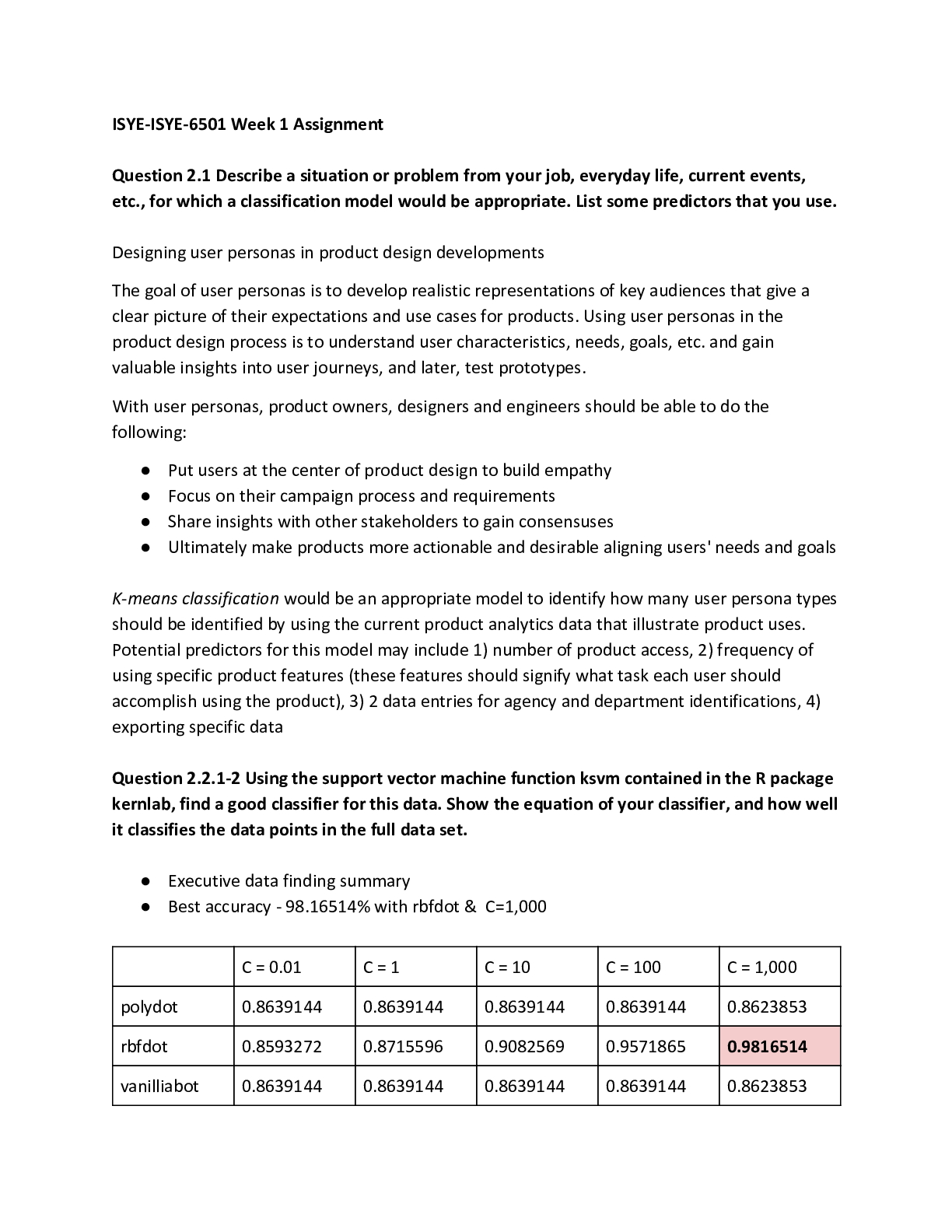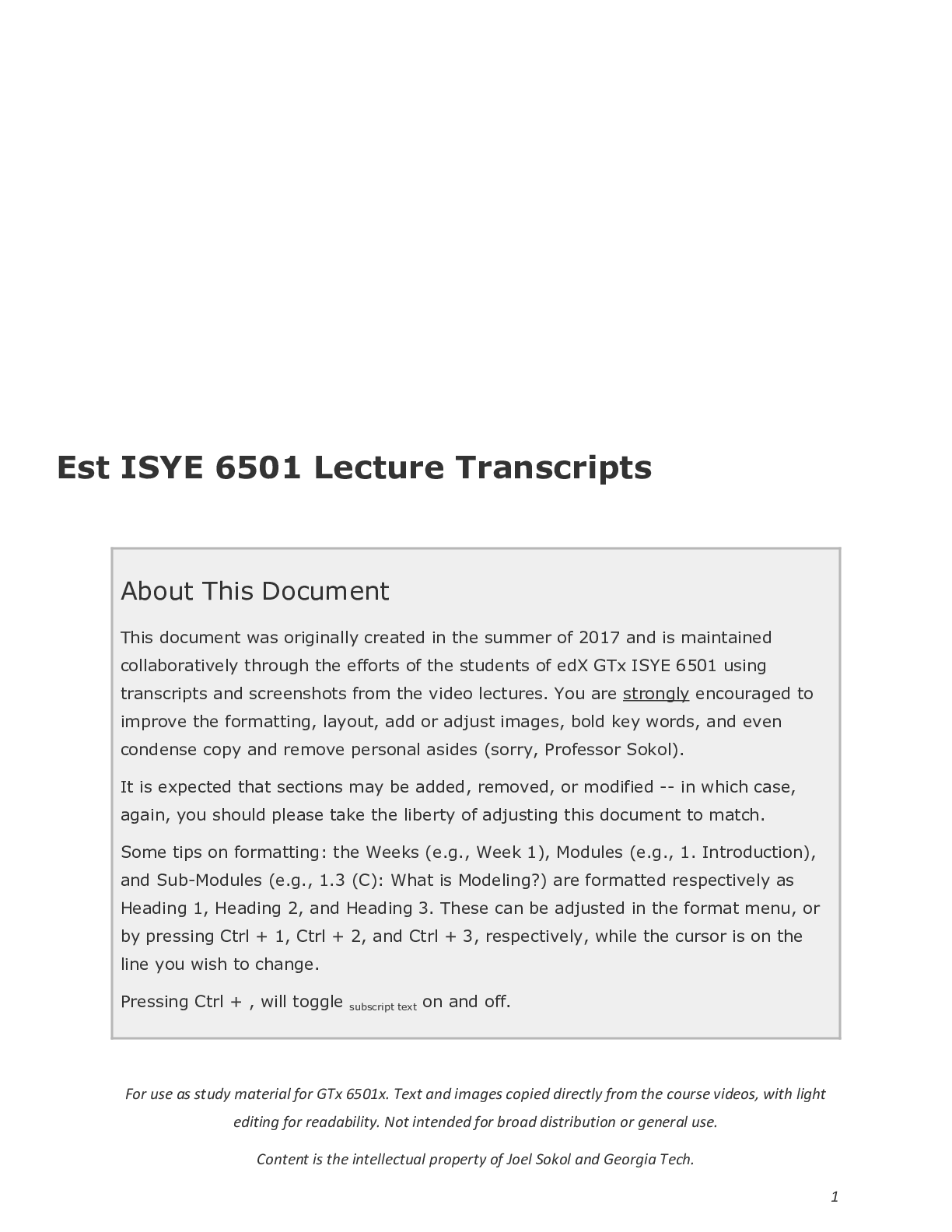Information Technology > QUESTIONS & ANSWERS > Georgia Tech ISYE-ISYE-6501 Week 1 Assignment, 100% Accurate answers, (All)
Georgia Tech ISYE-ISYE-6501 Week 1 Assignment, 100% Accurate answers,
Document Content and Description Below
ISYE-ISYE-6501 Week 1 Assignment Question 2.1 Describe a situation or problem from your job, everyday life, current events, etc., for which a classification model would be appropriate. List some pre... dictors that you use. Designing user personas in product design developments The goal of user personas is to develop realistic representations of key audiences that give a clear picture of their expectations and use cases for products. Using user personas in the product design process is to understand user characteristics, needs, goals, etc. and gain valuable insights into user journeys, and later, test prototypes. With user personas, product owners, designers and engineers should be able to do the following: ● Put users at the center of product design to build empathy ● Focus on their campaign process and requirements ● Share insights with other stakeholders to gain consensuses ● Ultimately make products more actionable and desirable aligning users' needs and goals K-means classification would be an appropriate model to identify how many user persona types should be identified by using the current product analytics data that illustrate product uses. Potential predictors for this model may include 1) number of product access, 2) frequency of using specific product features (these features should signify what task each user should accomplish using the product), 3) 2 data entries for agency and department identifications, 4) exporting specific data Question 2.2.1-2 Using the support vector machine function ksvm contained in the R package kernlab, find a good classifier for this data. Show the equation of your classifier, and how well it classifies the data points in the full data set. ● Executive data finding summary ● Best accuracy - 98.16514% with rbfdot & C=1,000 C = 0.01 C = 1 C = 10 C = 100 C = 1,000 polydot 0.8639144 0.8639144 0.8639144 0.8639144 0.8623853 rbfdot 0.8593272 0.8715596 0.9082569 0.9571865 0.9816514 vanilliabot 0.8639144 0.8639144 0.8639144 0.8639144 0.8623853> data=read.table("~/Desktop/GATech/ISYE-6501/Week1/credit_card_data-headers.txt",header = T,sep='\t') > library(kernlab) > model1v <- ksvm(as.matrix(data[,1:10]), as.factor(data[,11]), type="C-svc", kernel="vanilladot", C=0.1, scaled=TRUE) Setting default kernel parameters > model2v <- ksvm(as.matrix(data[,1:10]), as.factor(data[,11]), type="C-svc", kernel="vanilladot", C=1, scaled=TRUE) Setting default kernel parameters > model3v <- ksvm(as.matrix(data[,1:10]), as.factor(data[,11]), type="C-svc", kernel="vanilladot", C=10, scaled=TRUE) Setting default kernel parameters > model4v <- ksvm(as.matrix(data[,1:10]), as.factor(data[,11]), type="C-svc", kernel="vanilladot", C=100, scaled=TRUE) Setting default kernel parameters > model5v <- ksvm(as.matrix(data[,1:10]), as.factor(data[,11]), type="C-svc", kernel="vanilladot", C=1000, scaled=TRUE) Setting default kernel parameters > model1p <- ksvm(as.matrix(data[,1:10]), as.factor(data[,11]), type="C-svc", kernel="polydot", C=0.1, scaled=TRUE) Setting default kernel parameters > model2p <- ksvm(as.matrix(data[,1:10]), as.factor(data[,11]), type="C-svc", kernel="polydot", C=1, scaled=TRUE) Setting default kernel parameters > model3p <- ksvm(as.matrix(data[,1:10]), as.factor(data[,11]), type="C-svc", kernel="polydot", C=10, scaled=TRUE) Setting default kernel parameters > model4p <- ksvm(as.matrix(data[,1:10]), as.factor(data[,11]), type="C-svc", kernel="polydot", C=100, scaled=TRUE) Setting default kernel parameters > model5p <- ksvm(as.matrix(data[,1:10]), as.factor(data[,11]), type="C-svc", kernel="polydot", C=1000, scaled=TRUE) Setting default kernel parameters > model1r <- ksvm(as.matrix(data[,1:10]), as.factor(data[,11]), type="C-svc", kernel="rbfdot", C=0.1, scaled=TRUE) > model1r <- ksvm(as.matrix(data[,1:10]), as.factor(data[,11]), type="C-svc", kernel="rbfdot", C=0.1, scaled=TRUE)> model2r <- ksvm(as.matrix(data[,1:10]), as.factor(data[,11]), type="C-svc", kernel="rbfdot", C=1, scaled=TRUE) > model3r <- ksvm(as.matrix(data[,1:10]), as.factor(data[,11]), type="C-svc", kernel="rbfdot", C=10, scaled=TRUE) > model4r <- ksvm(as.matrix(data[,1:10]), as.factor(data[,11]), type="C-svc", kernel="rbfdot", C=100, scaled=TRUE) > model5r <- ksvm(as.matrix(data[,1:10]), as.factor(data[,11]), type="C-svc", kernel="rbfdot", C=1000, scaled=TRUE) > a1p = colSums(model1p@xmatrix[[1]] * model1p@coef[[1]]) > a1r = colSums(model1r@xmatrix[[1]] * model1r@coef[[1]]) > a1v = colSums(model1v@xmatrix[[1]] * model1v@coef[[1]]) > a2p = colSums(model2p@xmatrix[[1]] * model2p@coef[[1]]) > a2r = colSums(model2r@xmatrix[[1]] * model2r@coef[[1]]) > a2v = colSums(model2v@xmatrix[[1]] * model2v@coef[[1]]) > a3p = colSums(model3p@xmatrix[[1]] * model3p@coef[[1]]) > a3r = colSums(model3r@xmatrix[[1]] * model3r@coef[[1]]) > a3v = colSums(model3v@xmatrix[[1]] * model3v@coef[[1]]) > a4p = colSums(model4p@xmatrix[[1]] * model4p@coef[[1]]) > a4r = colSums(model4r@xmatrix[[1]] * model4r@coef[[1]]) > a4v = colSums(model4v@xmatrix[[1]] * model4v@coef[[1]]) > a5p = colSums(model5p@xmatrix[[1]] * model5p@coef[[1]]) > a5r = colSums(model5r@xmatrix[[1]] * model5r@coef[[1]]) > a5v = colSums(model5v@xmatrix[[1]] * model5v@coef[[1]]) > a1p A1 A2 A3 A8 A9 -0.0012124569 -0.0006070979 -0.0013956063 0.0033049356 1.0040211349 A10 A11 A12 A14 A15 -0.0031961704 0.0004545954 -0.0003748261 -0.0012915663 0.1064276327 > a1r A1 A2 A3 A8 A9 A10 0.4313879 2.4298212 2.7556247 7.0377742 17.9247112 -3.9792682 A11 A12 A14 A15 6.8491091 -0.8738477 -2.6108725 7.0446083 > a1v A1 A2 A3 A8 A9 -0.0011608980 -0.0006366002 -0.0015209679 0.0032020638 1.0041338724 A10 A11 A12 A14 A15 -0.0033773669 0.0002428616 -0.0004747021 -0.0011931900 0.1064450527 > a2p A1 A2 A3 A8 A9 -0.0011779029 -0.0007585829 -0.0015830018 0.0030741611 1.0045976382 A10 A11 A12 A14 A15 -0.0028875480 0.0001266113 -0.0006759177 -0.0013468793 0.1064496302 > a2r A1 A2 A3 A8 A9 A10 0.4548067 -1.9289825 4.1436685 14.2315520 31.7459310 -6.9658393 A11 A12 A14 A15 18.9744715 -5.0372010 -16.1513729 27.9249126 > a2 [Show More]
Last updated: 1 year ago
Preview 1 out of 9 pages
Instant download

Buy this document to get the full access instantly
Instant Download Access after purchase
Add to cartInstant download
Reviews( 0 )
Document information
Connected school, study & course
About the document
Uploaded On
Sep 03, 2022
Number of pages
9
Written in
Additional information
This document has been written for:
Uploaded
Sep 03, 2022
Downloads
0
Views
87














